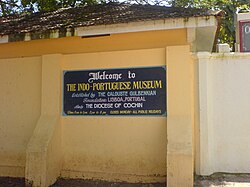Features
The museum has five main sections: Altar, Treasure, Procession, Civil Life and Cathedral. Among the pieces on display are a piece of the altar made in teak (16th century) from the Church of Our Lady of Hope, Vypeen; a chasuble (19th century) from Bishop's House, Fort Kochi; a processional cross, which is a combination of silver and wood (17th century) from Santa Cruz Cathedral, Fort Kochi; and an Indo-Portuguese monstrance (18–19th century) from the Church of Our Lady of Hope. Other objects on display at the Indo-Portuguese Museum are sculptures, precious metal objects and vestments, among others from the Cathedral of Santa Cruz and other churches of the Kochi diocese.
The Calouste Gulbenkian Foundation of Lisbon, Portugal, was directly involved in the selection of the artworks displayed in the Indo-Portuguese Museum of Cochin, being responsible for the museological layout. The artworks had been selected among various churches of Cochin area. The foundation also provided technical and financial assistance towards the erection of the building where the museum has been established since 2000 and has published a comprehensive catalogue, which is available at the museum.
This page is based on this
Wikipedia article Text is available under the
CC BY-SA 4.0 license; additional terms may apply.
Images, videos and audio are available under their respective licenses.



